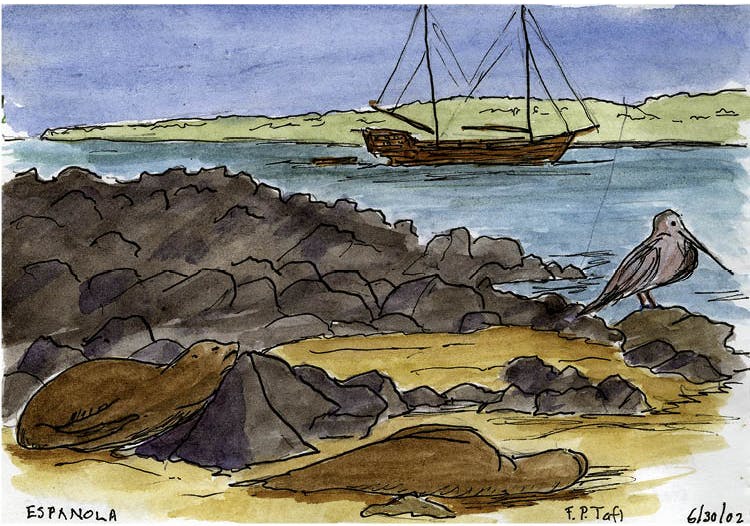
- Magazine Article
- Support
The Frances Taft Archive
The legacy of an intrepid and inspiring Clevelander

Sketchbooks, Franny brought one everywhere she went, and many of the resulting watercolors are in the archive.
Frances Prindle Taft traveled the world collecting art and creating her own in notebooks that she filled with colorful observations.
“She would take her sketchbooks everywhere,” remembers her son Frederick “Rick” Taft. “One setting was particularly beautiful yet challenging: she was at the Galapagos Islands, sitting on a rock at a beach with sea lions all around her as she painted.”
Much of Franny’s meticulous record of her life is now available in an archive that bears her name in the Ingalls Library and Museum Archives. Correspondence, paintings, photographs, travel journals, and films dating to the 1920s document a richly varied life that revolved around art and education. The archive reflects her lifelong penchant for doggerel commemorating special occasions and her love of letter-writing, scrapbooking, and journaling.

Leslie Cade, the CMA’s director of museum archives, oversaw the creation of the Frances Taft Archive. “The collection speaks to the depth and breadth of the Cleveland arts community,” she notes. “The people Franny corresponded with are leaders in the arts, with international reputations. And she was at the center of it all.”
Born in 1921 in New Haven, Connecticut, Franny majored in zoology with a minor in art history at Vassar College. She joined the Navy Reserve’s Women Accepted for Volunteer Emergency Service (WAVES) in 1942, serving until the end of World War II. In 1943 she married Seth Chase Taft, a grandson of President William Howard Taft. After she earned a master’s degree in art history from Yale University, the couple moved to Cleveland in 1948. Franny became involved in the CMA’s Junior Council (later the Womens Council) and then served on the museum’s board of trustees—eventually becoming a life trustee. She taught art history at the Cleveland Institute of Art (CIA) from 1950 to 2012.
The collection includes text and audio of her public lectures and correspondence with her students—many of whom she counted as friends—and prominent Cleveland artists such as John Paul Miller, Frederick Miller, Robert Little, and Bill and Leza McVey. In addition to documenting her travels—as well as organizing and guiding those of others—Franny was an active participant in the life of the city and maintained a busy schedule serving on multiple boards and committees for the CMA, CIA, Eleanor Roosevelt Center at Val-Kill, Case Western Reserve University, Laurel School, and Vassar.
A self-taught teacher and proponent of Pre-Columbian art, Franny traveled to Mesoamerica 19 times between 1966 and 2000. Rick remembers one trip when they viewed an athletic court where Mayans played a game that involved throwing a ball through a decorative ring attached high on a wall. “It was a game in which if you lost, you lost your life,” he recalls. “That was formative for me—the idea that it’s not just art we’re looking at, it’s a whole culture. She showed me examples of what humanity did long ago with its art and its power. Those lessons have affected my life.”

The year after Franny’s death in 2017, her children—Rick, Thomas, Cynthia, and Tucker—donated the bulk of her papers to the CMA archives and provided funding to catalog and process the materials. Kaitlin Schulz, who has a master’s degree in library information science from Kent State University, spent a year cataloging the archives and digitizing images, including the watercolors in Franny’s notebooks. “I tried to keep a journal while I was in college in Europe,” Schulz says. “When I saw hers, I thought mine paled in comparison. She’s an inspiring person with countless accomplishments. She makes me feel like I could do so much more.” Schulz is still scanning the slides that once filled four cabinets so that researchers may view them online. They cover a wide range of events, from Franny’s time in the WAVES to moments in Cleveland history such as the building of the Pepper Ridge community and Seth Taft’s campaign for mayor of Cleveland.
Franny was an early adopter of 16mm film. The archive contains many older films of events noted in her autobiography, Sketches from Life. More recent VHS tapes, DVDs, and cassettes portray family trips, school events, and her lectures. One of the Taft home movies shows the Hindenburg, emblazoned with the Nazi swastika, flying along the Connecticut shore. Footage from the war years captures an American fighter plane buzzing the family on a beach and the WAVES in training; some of these films are in vibrant color, a rarity in period footage. So far 22 of the 59 films have been digitized, and three are available online—one of which shows the extended Taft family at their summer home in Murray Bay, Canada, and includes a brief scene with President Taft.
The Ingalls collection doesn’t include some footage of one trip that Franny and Rick took to a spectacular Mayan site. “I was designated the 16mm photographer and shown how to use Mom’s beautiful Bolex camera,” Rick recalls. “I was anxious to do a good job. I put the first roll of film through the camera, and when it was done, I took it out and reached for the next roll, but I mistakenly put the same roll back in. That roll is not in the archives.”
